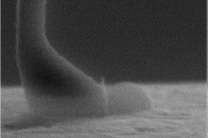Scientists take up golf to prove long-standing theory of cell stickiness

State-of-the-art, highly-sensitive golf clubs, developed by scientists, regularly catch the eye of golf's elite; however before the likes of Rory McIlroy get excited this time, this new golf putter is being put to use in microbiology laboratories.
The 'micro putter', developed in a study published today, 5 October 2011, in IOP Publishing's journal Measurement Science and Technology, has been designed to test the "stickiness" of single cells.
With a length of 240 micrometres, a width of 30 micrometres and a tip of just two micrometres, golfers would not even be able to see this new putter; one micrometre is equal to one-millionth of a metre.
Researchers from Nagoya University in Japan are using the micro putter to nudge individual yeast cells placed on a variety of surfaces to test cell adhesion.
Cell adhesion is the ability of a single cell to stick to other cells, or an exterior material, and has long been theorised as a way of testing if a cell is dead or alive.
According to the "cell adhesion model", the more a cell sticks the greater number of chemical bonds it has on its surface. A dead cell would have fewer chemical bonds on its surface so would therefore stick less than a living cell.
The research team has provided compelling evidence that this theory is correct, showing that a cell's adhesion is decreased by more than half once it's died.
Compared to conventional cell testing whereby averages are obtained by staining dead and living colonies with special dyes, the micro-putter could provide a fast and simple approach to testing individual cells and provide a more precise understanding of the biological processes that occur.
Co-author, Yajing Shen, said, "The identification of cell viability is very important in the biological and medical field. Take disease therapy for example: cell viability measurements could be used to evaluate the death of cancerous cells or evaluate cell damage due to toxins."
To fabricate the intricate details of the micro putter, charged particles were fired at a cantilever, using a technique known as focused ion beam (FIB), to remove material from its surface.
The micro putter was used to test the adhesion of live and dead yeast cells that were cultured in the lab for two days. The tests were carried out in an environmental scanning electron microscope (ESEM) – a high-powered microscope that allows the user to image specimens when they are wet, meaning cells can be visualised in their natural environment.
Once inside the ESEM, the yeast cells were delicately placed on three surfaces of varying cell adhesion – tungsten, gold and indium tin oxide – and nudged with the micro putter until they were removed from their spot. The microscope was able to capture images of the movement of the cells whilst the tiny deflection of the putter was recorded as a measure of the cell's adhesion.
The adhesion force of a living cell was approximately 19 micronewtons, three times the force of a dead cell which had a value of approximately six micronewtons, confirming the 'cell adhesion model'.
"We hope the micro putter can be used to evaluate the actual health conditions of cells in the future. Combined with a single cell surgery technique, the micro putter could help to understand the mechanisms of disease and develop effective new drugs," continued Shen.
More information: The published version of the paper "Single cell adhesion force measurement for cell viability identification by using AFM cantilever based micro putter" Shen et al 2011 Meas. Sci. Technol. 22 (11) 115802 will be freely available online from 5 October 2011. It will be available at iopscience.iop.org/0957-0233/22/11/115802
Provided by Institute of Physics

















